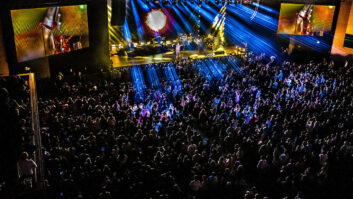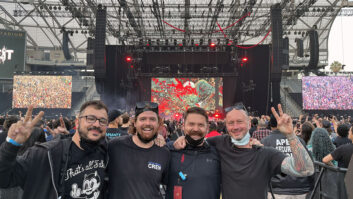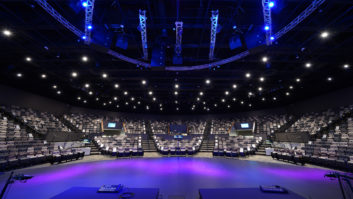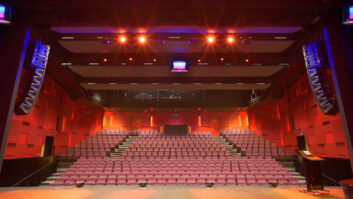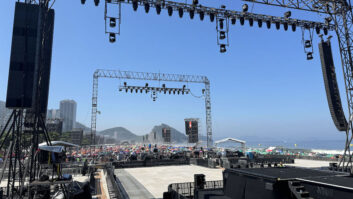
Meyer Sound Galileo features CP-10 phase-parametric EQ on each audio I/O.
There’s nothing like the joy of assembling a new P.A. system. The sweet smell of new cabinetry, manuals everywhere and enough audio wiring to entertain a snake charmer. The best part is building and prepping the drive rack — connecting the audio routers, crossovers, equalizers and delay lines, and then fine-tuning it. Of course, after you’ve spent a week painstakingly dialing in the crossover, EQ and delay settings, somebody comes along and changes everything when you’re not looking.
Luckily, audio manufacturers felt our pain and created the system controller or drive processor. Typically incorporating graphic and parametric EQ, dynamics, crossover, delay, feedback elimination and audio routing, these controllers make touring life easier by consolidating gear that previously existed in a separate chassis. This combined functionality reduces the amount of wiring and rack real estate, a valuable asset especially in small venues.
In addition to the audio functions previously mentioned, most system controllers feature preset and user libraries, and the ability to access them via MIDI, USB or a memory card. This is great for traveling systems in which custom profiles can be created and recalled for use in different venues. Some controllers furnish preconfigured crossover setups or presets for specific loudspeakers to get you up and running quickly. For example, the dbx DriveRack unit ships preloaded with crossover settings for certain JBL loudspeakers, removing the guesswork while saving you time in the process.
Front panel muting, metering and level adjust are a must, and — as it won’t be long before analog wiring resides in the Museum of Radio and Television — it’d be wise to choose a device with digital I/O capabilities. More and more manufacturers are providing Ethernet ports and software for control via PC, and you’ll find at least one controller (the Dolby DLP) that allows you to remotely make/break ground on audio channels for much faster troubleshooting of ground loops. Security lock-out for the front panel can keep snooping sniffers out of your precious audio parameters.
Some loudspeaker manufacturers produce system controllers optimized for use with their own products, and system control integrated with power amplifiers is on the horizon. Let’s look at some system controllers from a variety of audio manufacturers, listed alphabetically.
A BREAKDOWN OF THE UNITS
The Intelli-Q 22 (about $5,700) from Apex (www.apex-audio.be) is a 2-channel processor for stereo or dual-mono use. Each channel has 30-band, constant-Q graphic and 10-band parametric EQ, high- and lowpass filters, shelf EQ, 2-band compressor with adjustable crossover and a look-ahead limiter on the audio outputs. Sidechain inputs allow control over the dual-band compressor or can feed a built-in RTA. AES-3 I/O is available as an option, and a universal switch-mode power supply facilitates worldwide use.
Apex’s Intelli-X 48 (about $7,900) comes in a 4×8 configuration, allowing XLR connectors to be switched between analog and AES-3 digital input. Up to 256 filters may be used simultaneously, including 30-band, constant-Q graphic, 8-band parametric and 2-band shelf EQ per input, plus 8-band parametric and 2-band shelf EQ per output. All Apex controllers may be accessed via the company’s Intelli-Ware PC software for real-time control.
The 4.24C Protea System II ($1,795) from Ashly (www.ashly.com) is a 4×8 digital crossover/system processor employing active, balanced I/O and 24-bit/48kHz conversion. Input processing includes gain, delay and six filters (parametric, low- or high-shelf), while output processing includes crossover, four filters, delay, polarity reverse and compression/limiting. The 4.24C may be programmed and run from the front panel or via MIDI, Ashly’s Protea System Software (Windows) or SIA Smaart software. Preset recall, input level, output level and mute functions can also be controlled by an AMX NetLinx system.
With 3×6 audio I/O, Ashly’s Protea 3.24CL ($1,035) was designed for use in small systems. Each input provides control over gain, delay and six filters (parametric, low- or high-shelf). Each output provides four filters (parametric, low- or high-shelf), delay, crossover, gain, polarity and compression/limiting for speaker protection, and may be assigned to any combination of inputs. Conversion is 24-bit/48kHz, and the 3.24CL provides four levels of security.
Behringer‘s (www.behringer.com) Ultradrive Pro DCX 2496 ($339.95) loudspeaker-management system has a 3×6 configuration, with 24-bit/96kHz conversion and four different operating modes. One of the analog inputs is switchable to an AES/EBU digital input. Onboard sample rate conversion allows easy connection of incoming digital signals with sample rates from 32 to 96 kHz. Zero-attack limiters on all output channels provide optimal signal protection.
Nexia SP ($1,999) from Biamp (www.biamp.com) provides up to 4×8 routing. System configuration is user-definable via daVinci PC software, and you can create multi-unit systems using Ethernet and NexLink digital audio linking. DSP includes a variety of mixers, graphic and parametric EQ, high- and lowpass filtering, two/three/four-way crossovers, dynamics, delay and a signal generator. Rear panel NexLink ports facilitate linking of multiple units for larger systems, and an RS-232 port links a variety of optional third-party remote-control devices.
Biamp’s AudiaSOLO ($3,998) is available in 12×4, 4×12 and 8×8 versions with balanced I/O on barrier-strip terminals. Inputs accept mic or line-level signals. AudiaSOLO has a minimalist front panel; Biamp provides software for system design, control and diagnostics via PC. Once a system design is compiled, it’s downloaded into AudiaSOLO, where it can be controlled via third-party systems such as AMX and Crestron via daVinci software and/or via dedicated Audia remote-control panels.
The latest addition to the dbx (www.dbxpro.com) line of DriveRack processors is the DriveRack PX ($599.95), which is designed for use with powered loudspeakers. This 2×2 controller has supplemental subwoofer outputs, and a Setup Wizard includes profiles for JBL and other powered speakers; patented AFS™ Advanced Feedback Supression kills problematic frequencies, allowing higher gain-before-feedback. DSP includes dual 28-band graphic EQ, stereo multiband parametric EQ, PeakStopPlus limiting, classic dbx compression and sub-harmonic synthesis from the dbx 120A. A front panel mic input allows performing RTA with the (included) dbx M2 measurement mic.
The 4800 ($4,999.95) is the flagship of dbx’s DriveRack Series, boasting 4×8 analog and 4×8 digital I/O. The 4800 may be run at sample rates of 48 or 96 kHz for a dynamic range of 116 dBA. In its complement of DSP are 31-band graphic and 9-band parametric EQ per input; crossover routing configurations with Bessel, Butterworth or Linkwitz-Riley filters; 6-band parametric on every out; loudspeaker cluster; and driver alignment delays, plus selectable inserts on every channel. The 4800 is compatible with HiQNet control and offers a CobraNet option.
The DLP (Dolby Lake Processor) from Dolby (www.dolby.com) is a sophisticated audio processor “main frame” for live and studio apps. Combining proprietary technology from Dolby Labs, as well as Lake Contour and Lake MESA EQ, the DLP comes in configurations ranging from the LPD (digital I/O only) up to the LP4D12 (4×12 analog I/O). The rear panel features balanced analog XLR I/O, and eight channels of AES/EBU and S/PDIF optical I/O. The DLP performs crossover, delay and limiting functions, as well as convolution reverb for creating natural-sounding impulse responses without the need to sample spaces. Recent updates include Dante, a digital audio networking format that addresses some of the weaknesses of other audio networks, and a firmware upgrade for 8×16 digital audio networking at no additional cost. Ethernet ports connect the DLP to a network. Price varies with configuration.
The Dynacord (www.dynacord.com) DSP 260 ($980) is a 24-bit system controller with 2×6 audio I/O. In addition to EQ, delay and limiting per channel, it offers global parametric and graphic EQ, delay and crossover. DSP 260 presets can be written from the front panel or via companion editing software, and presets that are compatible with Dynacord’s DSP 244 are available for the company’s loudspeaker systems. An RS-232 interface allows slave operation of multiple devices, and a 6dB pre-A/D pad switch prevents input overload.
EAW‘s (www.eaw.com) UX8800 ($3,325) 4×8 incorporates two distinct modes of operation. In System Processor mode, user-adjustable functions include EQ, filters, delay, gain, crossover, limiter and polarity. In Loudspeaker Processor mode, preset processing is available for EAW loudspeakers and arrays with Gunness Focusing. In this mode, the UX8800 corrects loudspeaker anomalies that cannot be corrected with conventional DSP. Standard Ethernet protocol and hardware-enabled computer control are offered through EAW’s Pilot software for easy plug-and-play Ethernet communication. Audio and control signals can be transmitted between up to 254 additional devices using the built-in 32-channel U-Net network.
The MX8750 ($2,775) was designed to complement EAW loudspeakers. Functions for the 2×8 unit include crossover (seven types) parametric and shelf EQ, high- and lowpass filters, delay, polarity and limiting. Six bands of parametric EQ are available per input, as are five bands per output. Analog audio I/O is on balanced XLR connectors with 24-bit/48kHz conversion. The MX8750 may be controlled using EAW software and a PC with an RS-232 interface or via MIDI.
The DC-One ($980) 2×6 system controller from Electro-Voice (www.electrovoice.com) has analog I/O on balanced XLR connectors, with DSP being 24-bit/48kHz with 32-bit, floating-point internal processing. Loudspeaker presets are available for automatic configuration of EQ and crossover settings, providing enhanced sonic performance while protecting loudspeaker components. Analog inputs feature Thru connectors for distribution of audio to additional DC-One processors for use with larger systems. A front panel USB interface with the company’s DC-One Editor software supports advanced editing and control via PC.
Klark Teknik‘s (www.klarkteknik.com) Helix DN9848E ($5,250) system controller is fully programmable, with input processing of gain, compression, parametric EQ and delay. Output processing includes configurable routing, delay, cascaded all-pass phase-correction filters, low- and highpass crossover, filters with a variety of slopes and characteristics, and six bands of parametric EQ. AES/EBU digital inputs are standard and are 96kHz-compatible for connection to external devices with high sample rates. Dual-port Ethernet increases communication speed over serial ports, while the company’s proprietary ELGAR software can be used for remote access and control over the DN9848E.
The Meyer Sound (www.meyersound.com) Galileo 616 has six balanced analog inputs, three of which are individually switchable to AES/EBU digital inputs, enabling the unit to simultaneously accommodate analog and digital sources. Its 16 balanced analog outs deliver signal levels up to +26 dBu, driving self-powered loudspeakers to full output. Each audio I/O includes Meyer’s CP-10 complementary phase-parametric EQ (five bands on inputs, 10 bands on outputs), with TruShaping filters to avoid the phase shift that can degrade intelligibility and signal clarity. Ethernet enables remote control via PC/Mac running Meyer Sound Compass control software, while bidirectional communication ensures that the user is always viewing active settings. Galileo 616’s AC power switch is software-activated, so accidental button-pushes cannot turn off the unit’s power.
Nexo‘s (www.nexo-sa.com) NX 242 ($3,170) is a 2×4 processor with electronically balanced, 24-bit analog I/O and a latency of only 2.2 ms. The NX 242 was designed to support all Nexo GEO, Alpha and PS loudspeakers, providing crossover, driver protection and system alignment matched to each Nexo component. An EtherSound interface ($5,170) enables connection to the NXtension-ES4 for remote control and distribution of digital audio, while Nexo’s ND 242 TDController supports monitoring of amp status and I/O levels via PC. The NX 242’s onboard Flash EPROM allows system firmware to be updated by the user.
The Digitool MX ($1,699) from Peavey Architectural Acoustics (aa.peavey.com) is a programmable system controller employing 32-bit parallel SHARC processors. Audio I/O is 8×8 on balanced Euro connectors, with inputs accepting mic or line-level. Sample rates up to 96 kHz are supported with 24-bit conversion. In addition to input high- and lowpass filtering, the Digitool MX features a noise gate, shelf and parametric EQ, compressor, 5-band paragraphic EQ, output filtering, output delay and a signal generator. Access to internal settings can be restricted with a user-defined password.
Peavey‘s (www.peavey.com) VSX26 ($559.99) programmable processor has 3×6 balanced audio I/O. A front panel XLR input with phantom power can be used for measurement mic input or as an extra audio input. DSP capabilities include input graphic EQ, dynamics and delay, plus five independent filters for use on the audio outputs, including parametric, notch, horn EQ, low- and highpass filters with varying slope, bandpass, and high- and low-shelf EQ. Front panel USB ports allow the VSX26 to manage presets with a memory stick or connect to a PC for use with graphic editing software.
Boasting presets customized for its loudspeakers, the SC28 System Controller ($1,331.66) from QSC (www.qscaudio.com) is a 2×8 device with 32-bit, floating-point processing with 24-bit/48kHz conversion. DSP tunings incorporate IIR (Infinite Impulse Response) and FIR (Finite Impulse Response) filtering for compensation of inherent transducer and waveguide response anomalies. System configurations are selected by scrolling through a list of QSC loudspeakers and selecting the desired crossover profile (two-way, three-way, etc.). A similar process is used to identify QSC amplifiers in the system, taking into consideration the amp’s sensitivity. A rear panel USB port allows new tunings to be easily loaded into the SC28.
Rane‘s (www.rane.com) RPM 26z ($999) can be drag-and-drop-configured on any PC with Ethernet and Windows XP using Rane’s Drag Net software. The device provides a 2×6 analog I/O and an AES-3 digital input. All I/O has a user-defined processing path that can include gain, parametric, bandpass, all-pass, high- and low-shelf and -cut filters; crossovers with varying slopes and characteristics; compression; limiting; and automatic gain control. Rear panel Euroblock connectors and ground screws for direct connection to chassis help solve EMI issues due to shield wiring. Multiple units are controllable from a single PC via Ethernet.
Sabine‘s (www.sabine.com) Navigator Series ($995) are available in configurations ranging from 2×4 to 8×8 with Ethernet capability. Every Navigator features front panel control and 24-bit conversion with 40-bit extended processing via SHARC processor. Each audio channel has control over gain and polarity, up to eight parametric filters, a variety of crossover filters and slopes, high- and low-shelf EQ, FBX Feedback Exterminator, comp/limiter and delay adjustable in 21ms increments. Navigator Remote Control software displays system status and provides access to all parameters via PC.
The Integrator Series Deuce 722 ($849) from Symetrix (www.SymetrixAudio.com) is an audio DSP toolbox with two analog ins and outs accommodating mic or line-level input. Mic preamp, compression, expansion, de-essing, AGC, ambient noise compensation, feedback elimination and EQ are all performed in the single-rackspace unit. A rear panel Ethernet jack combined with a Windows interface facilitates setup and editing of parameters. Applications for the Deuce 722 include front-of-house speaker management, monitor EQ and feedback elimination, voice processing for P.A. and paging over background music.
The EQ Station ($5,245 to $9,345, depending on configuration) from TC Electronic (www.tcelectronic.com) runs eight channels of analog I/O on balanced XLR connectors, sampling at 6.1 MHz with 24-bit resolution. Dedicated front panel encoders for frequency, bandwidth and gain provide control over graphic, parametric and dynamic EQ. Each channel has 6-band parametric EQ, 29-band graphic EQ with four types of filtering, 3-band dynamic EQ or 2-band “paradynamic” EQ, peak limiter and delay. Channels may be linked for stereo operation, and an optional expansion card accepts AES/EBU digital I/O. VirtualEQ Station software allows the unit to be remotely controlled from a PC using standard TCP/IP protocol. MotoFader 64 is a companion remote featuring 29 motorized faders with instant access to 64 channels of graphic EQ.
The EQ Station ($5,245 to $9,345, depending on configuration) from TC Electronic (www.tcelectronic.com) runs eight channels of analog I/O on balanced XLR connectors, sampling at 6.1 MHz with 24-bit resolution. Dedicated front panel encoders for frequency, bandwidth and gain provide control over graphic, parametric and dynamic EQ. Each channel has 6-band parametric EQ, 29-band graphic EQ with four types of filtering, 3-band dynamic EQ or 2-band “paradynamic” EQ, peak limiter and delay. Channels may be linked for stereo operation, and an optional expansion card accepts AES/EBU digital I/O. VirtualEQ Station software allows the unit to be remotely controlled from a PC using standard TCP/IP protocol. MotoFader 64 is a companion remote featuring 29 motorized faders with instant access to 64 channels of graphic EQ.
XTA‘s (www.xta.co.uk) DP448 ($5,795) has a 4×8 audio I/O with 96kHz/24-bit processing. To facilitate configuration of new systems, it features templates with preset system routing and crossover points that can be user-tuned. Any audio output may be fed from any input, or combination of inputs, forming a flexible matrix. Input functions include 28-band graphic EQ and eight bands of parametric EQ, while output processing features nine parametric bands per output and crossover filters with slopes ranging from 6 to 48dB/octave. Also available is high- and low-shelf EQ, look-ahead limiting and phase adjustment in 2-degree increments. Audiocore PC software provides quick linking of I/Os, and up to 128 units are networkable using standard XLR cables.
The DME Digital Mixing Engine Series of controllers from Yamaha (www.yamahaproaudio.com) combine mixer, EQ, crossover, dynamics control, feedback suppression and even WAV file players. The DME64N ($6,500) and DME24N ($3,600) feature 24-bit/96kHz DSP using Yamaha’s DSP7 chip for audio processing. The DME64N has four rear panel Yamaha Mini-YGDAI expansion slots, allowing up to 64 I/O channels to be added. The DME24N features eight built-in analog I/Os and one Mini-YGDAI slot for an additional 16 channels. Expansion card options include analog or digital I/O in a variety of formats. DME Satellite Series network interfaces can be used to expand a DME system to CobraNet or EtherSound networked audio protocols, enabling remote-control I/O and distributed processing for increased system flexibility. DME Designer software runs on most Windows-based computers, allowing a user to graphically compile the audio components required for a particular system.
In addition to being Mix‘s sound reinforcement editor, Steve La Cerra mixes front of house for Blue Öyster Cult.
